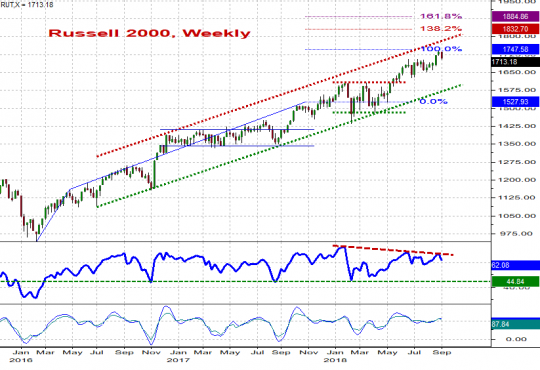[vc_row el_id=”Commentary”][vc_column][vc_column_text]
S&P 500 to Gold ratio flirting with long-term resistance
Rotation of capital in financial markets is a reality because of the market and economic cycles but also because investors price assets not only based on their own merits but also in relation to peers and competitors. Like everything else, the perception towards what and asset is worth in relation to another asset fluctuates in time and is a function of patterned mass psychology – and thus trends. Just plot an index or a futures contract or a stock chart side-by-side with any ratio of two related instruments – asset classes, sectors, industries, competing firms – and you will understand quickly that the same principles universally valid in technical analysis apply to ratios as much as they apply to individual instruments.
Rotation must obviously be put in perspective. It always happens because of certain momentum as well as economic fundamental considerations. The higher you climb on the investment pyramid, i.e. from the firm to the group, industry or sector level and then to asset classes, the less frequent it happens. Asset class rotations, in fact, happen only once every few years, very much with the frequency of appearance of tectonic economic fundamental shifts which by definition take a lot of time to emerge and unfold.
Consider the stocks to gold ratio for instance. It reflects aggregate investor attitudes towards growth and risk on one hand and inflation expectations on the other hand. In the past twenty years we have had a total of two major trend changes with probably a third one coming up: one in July 1999, one in August 2011 and one possibly coming up in late 2018 / early 2019. If you go back to the past forty five years we had two or three more, one in 1973, one in 1976 and one in 1980. This means a major trend change, on average, takes place every 6.7 – 7.5 years, reflecting the amount of time needed by the economy and the markets to transit back and forth from an extreme situation of high inflation / high risk / low growth to an extreme situation of low inflation / low risk / high growth. This is rather logical as the macro-economic factors required to make those transitions take time to undertake, be recognized and push to the limits.
There are several reasons why I think we should talk about this stocks – gold ratio at the moment. First off, we are counting on the current stock market advance to close a significant mid-term cycle and understanding our bigger picture options may be of some significance after 9 + years of equity markets rally. Secondly, the ratio itself is in the territory of important mid-term resistance levels. Thirdly, we are 7.1-7.2 years since the last trend change in the ratio which is right within the 6.7-7.5 years average time to rotation experienced in the past 2-5 decades. Finally Gold’s overall mid-term pattern is sideways at best and bearish at worst so by extension that would not have massively positive implications for stocks in the context of our bearish stocks – gold ratio outlook.
 The chart above illustrates one of my points: the S&P 500 to Gold ratio is approaching mid-term resistances. The first zone is 2.2627 – 2.5277 coinciding with the lower boundary of the 2003-2005 sideways correction and the initial (38.2%) Fibo retracement of the entire 1999-2011 down cycle. The second zone is 2.9302-3.1147 coinciding with the upper boundary of the 2003-2005 bounce and the 50% fibo retracement of the 1999-2011 decline. The ratio will run into trouble quite possibly at the initial resistance range but no later than the second one. The short-term momentum condition suggests we may have only a temporary peak here, a pullback and a final high on diverging momentum early next year but of course these are all idealized scenarios that may or may not play out with tick precision in the current environment. The important thing to retain is that after more than 7 years of rallying in the ratio and 9 years in the stock indices themselves, the technical landscape can easily accommodate the beginning of a trend of underperformance of stocks relative to gold. Historically, this coincided with important stock market peaks and I see no reason why the current situation would be different.
The chart above illustrates one of my points: the S&P 500 to Gold ratio is approaching mid-term resistances. The first zone is 2.2627 – 2.5277 coinciding with the lower boundary of the 2003-2005 sideways correction and the initial (38.2%) Fibo retracement of the entire 1999-2011 down cycle. The second zone is 2.9302-3.1147 coinciding with the upper boundary of the 2003-2005 bounce and the 50% fibo retracement of the 1999-2011 decline. The ratio will run into trouble quite possibly at the initial resistance range but no later than the second one. The short-term momentum condition suggests we may have only a temporary peak here, a pullback and a final high on diverging momentum early next year but of course these are all idealized scenarios that may or may not play out with tick precision in the current environment. The important thing to retain is that after more than 7 years of rallying in the ratio and 9 years in the stock indices themselves, the technical landscape can easily accommodate the beginning of a trend of underperformance of stocks relative to gold. Historically, this coincided with important stock market peaks and I see no reason why the current situation would be different.
Remember, however, that we are talking about ratios here. The Stocks – Gold ratio can fall because of falling stocks, rising gold or a combination of both. If we can determine that Gold’s overall trend is NOT too bullish, however, then we have a more solid argument that the pattern we see in the ratio is likely previewing the kind of projected mid-term weakness we are beginning to see in the major indices. So what does the Gold’s pattern itself suggest?
I can take you into the intricacies of Gold’s own pattern but I will keep it to the level of basic trend analysis here. An uptrend is defined as a sequence of higher highs and higher lows and on the larger time horizons we haven’t seen one in many years in Gold. A downtrend is defined as a sequence of lower highs and lower lows such as the one we’ve seen between late 2011 and late 2015. A sideways trend is defined as a sequence of horizontal highs and lows, sometimes confined to flat resistance / flat support lines and sometimes confined to falling resistance / rising support lines. This is what we have seen since 2015. Overall, on the weekly chart we are looking at a sideways trend in Gold that develops after a big downtrend and as I always say “sideways after down is rarely bullish” – much like sideways after up is rarely bearish. This means that UNLESS Gold can cross fibo and structural resistance at 1300-1380 its mid-term trend is not bullish. And even if that area briefly gave way in the event of some geopolitical shock or some other event, follow through would be limited at the 1490 / 1590 overhead resistance zones and a hard hit would ensue up there. Based on all this, eventual weakness in the Stocks – Gold ratio is less likely to come from Gold strength and more likely from Stocks weakness, which as I said is entirely compatible with what we see on the weekly charts of the major US stock indices at the moment.
 [/vc_column_text][/vc_column][/vc_row][vc_row el_id=”SP500″][vc_column][vc_column_text]
[/vc_column_text][/vc_column][/vc_row][vc_row el_id=”SP500″][vc_column][vc_column_text]
Pattern Analysis
S&P 500, Daily
The slide in the 2nd part of last week is heavier than it “should” be and for that reason it is somewhat alarming – especially considering our larger mid-term topping outlook. Momentum, however, has yet to really deteriorate so we’ll adjust near-term key support at 2862.90 and then 2848 and remain hopeful for a push to a new recovery high above 2905. Do protect yourself below 2848 because a slide under it opens the door for an immediate decline towards 2799 / 2740 / 2691.

S&P 500, Weekly
Unchanged:::: Pattern structure, momentum, channeling and pretty much every technical measure suggest the best part of growth in the mid-term uptrend from the 2016 lows is over. In this time frame, a move to new highs is likely to yield the largest correction in at least 2-3 years.
 [/vc_column_text][/vc_column][/vc_row][vc_row el_id=”SP400″][vc_column][vc_column_text]
[/vc_column_text][/vc_column][/vc_row][vc_row el_id=”SP400″][vc_column][vc_column_text]
S&P 400, Daily
The decline last week is not particularly worrisome in the near-term, though it appears more and more likely that the lack of immediate follow through on the recent move to new highs pertains to an eventual (BEARISH !!!) RISING WEDGE pattern. If this assessment is correct, the MidCaps should currently remain supported above 2001 and then rise one last time above 2050 and possibly within the 2070-2080 range to complete the wedge structure. As an alternate scenario, any push below 2001 should be treated as an early sign we were already headed for 1961 / 1930 / 1853.

S&P 400, Weekly
Unchanged :::::: New highs in price have thus far gone unconfirmed by weekly momentum. It is likely that as the short-term uptrend matures the largest correction in 2-3 years ensues. A push towards at least 1795 – 1853 would then be in cards.
 [/vc_column_text][/vc_column][/vc_row][vc_row el_id=”SP600″][vc_column][vc_column_text]
[/vc_column_text][/vc_column][/vc_row][vc_row el_id=”SP600″][vc_column][vc_column_text]
S&P 600, Daily
The Small Caps are still hanging in there and that alone is a positive sign. We remain hopeful for a rally towards 1124 while prices trade above 1068 / 1055 but we also remain aware that the overall upside potential pertains to the late stages of the advance that started in May near 940. Stubbornly standing by the bull below 1055 holds high potential of being a very costly mistake …….

S&P 600, Weekly
Unchanged :::: Targets / resistances in this time frame are located at 1114 / 1169. However, the need to redraw (i.e. steepen) the mid-term upside channel in the small caps ONLY speaks volumes as to where we are in the overall market cycle (recall that small caps outperform mid and large caps at the end of the major bull cycles). As we said before we are sellers into strength in this time frame.
 [/vc_column_text][/vc_column][/vc_row][vc_row el_id=”INDU”][vc_column][vc_column_text]
[/vc_column_text][/vc_column][/vc_row][vc_row el_id=”INDU”][vc_column][vc_column_text]
Dow Industrials, Daily
As long as INDU trades above the progressively more critical supports of 25,608 / 25,414 / 25,000, it does retain the potential to push towards 26,555 to somehow complete a thrust out of the February – May triangle. Things will turn considerably more bearish below the pivotal 25,000 area with initial downside targets located at 24,250 / 24,004.
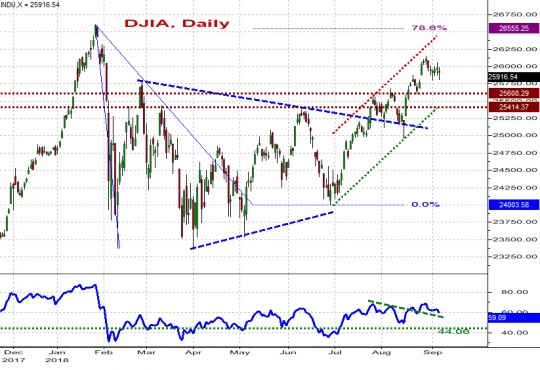
Dow Industrials, Weekly
UNCHANGED ::::: The problem the DJIA faces right now is that yes, the intermediate – term uptrend would typically complete with a push to a new high on diverging momentum but no, such a push is not an absolute must because the force and persistence of the 2017 rally handsomely allow for the formation of a double top or even a “failure” (a situation when the final leg of a trend does not manage to achieve a new price extreme).
 [/vc_column_text][/vc_column][/vc_row][vc_row el_id=”TRAN”][vc_column][vc_column_text]
[/vc_column_text][/vc_column][/vc_row][vc_row el_id=”TRAN”][vc_column][vc_column_text]
Dow Transportation, Daily
The little sideways pattern developing in between nearby key support and key resistance is a positive. But a push above 11,410 is still required to mitigate the inevitable downside risk facing TRAN on the retest of the previous multi-month high. Upside targets once / if we break above 11,410 remain near 11,810; downside targets if we “lose it” below the 11,256 – 11,131 supports are located 10,850 and then 10,400.
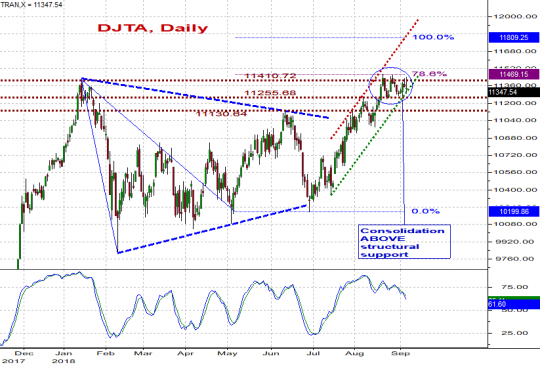
Dow Transportation, Weekly
UNCHANGED ::::: The inability to build any meaningful upside momentum following that successful retest of trendline support earlier this year is worrisome, especially since at the early 2018 highs the Tranies already posted a bearish momentum divergence vs the previous peak reached in early 2017. From a Dow Theory perspective, a new high in the DJIA / SPX / Mid and Small Caps that goes unconfirmed by the DJTA would be both a terrible setup and, historically, the typical way to end a mid-term uptrend.
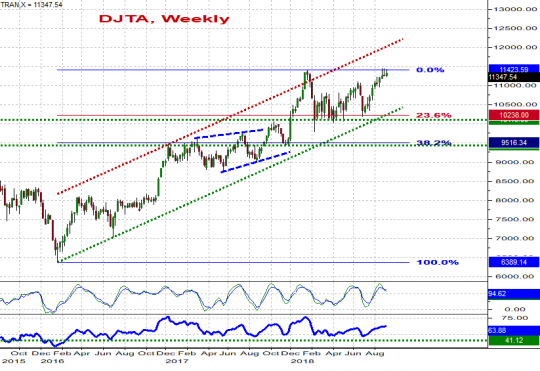 [/vc_column_text][/vc_column][/vc_row][vc_row el_id=”UTIL”][vc_column][vc_column_text]
[/vc_column_text][/vc_column][/vc_row][vc_row el_id=”UTIL”][vc_column][vc_column_text]
Dow Utilities, Daily
Repeat :: Support at 721 / 712 has yet to give way but the Utilities continue to do rather terrible. We continue to believe the 2018 rebound is corrective in nature and will soon morph into an important short-term decline towards and likely below the 650 area.

Dow Utilities, Weekly
UNCHANGED :::: With the back-end of the yield curve pushing higher and with a seemingly complete 2010-2017 bull run which as you can see developed nicely inside two parallel channel lines, odds favor a sharp retreat in the utilities. We’re targeting the 590-620 area at some point in late 2018 / early 2019.
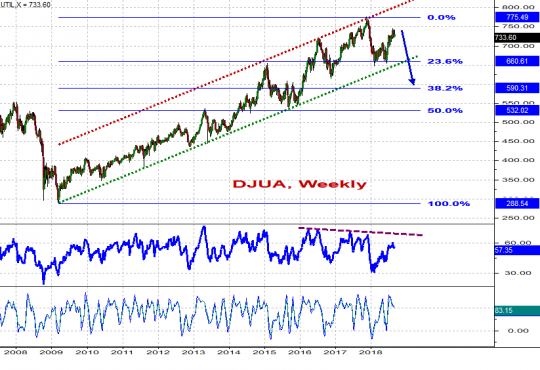 [/vc_column_text][/vc_column][/vc_row][vc_row el_id=”RUI”][vc_column][vc_column_text]
[/vc_column_text][/vc_column][/vc_row][vc_row el_id=”RUI”][vc_column][vc_column_text]
Russell 1000, Daily
Support at 1578 / 1555 should contain downside as the RUSSELL 1000 eventually builds a base for a push above 1620. The near-term picture will become considerably more difficult below 1556 with a drop towards 1497 quite possibly immediately in cards.
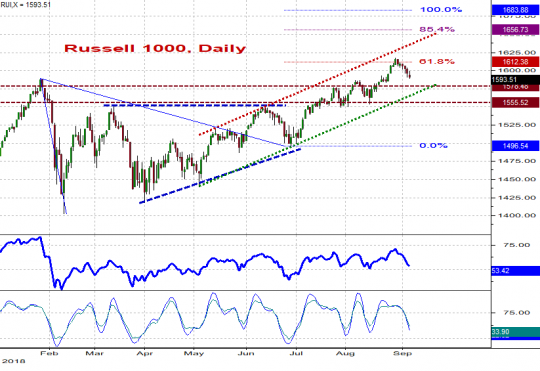
Russell 1000, Weekly
UNCHANGED :::: Targets / resistances for the final mid-term uptrend currently intervene at 1634 / 1670. We are highly suspicious a significant correction will begin near one of them.
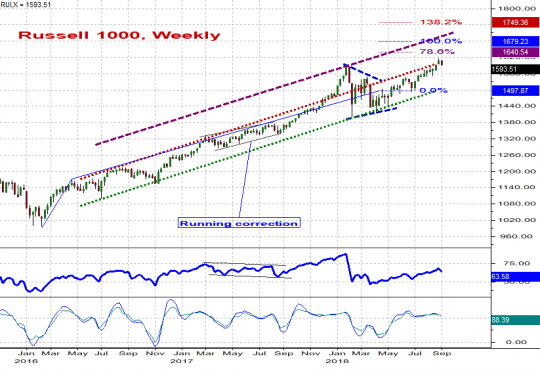 [/vc_column_text][/vc_column][/vc_row][vc_row el_id=”RUT”][vc_column][vc_column_text]
[/vc_column_text][/vc_column][/vc_row][vc_row el_id=”RUT”][vc_column][vc_column_text]
Russell 2000, Daily
The pattern in the Russell 2000 is sort of a hybrid between SP400 and SP 600 – tilted perhaps towards SP 600. Support is located at 1697 / 1675 and should hold as RUT attempts to form a near-term base and rally above 1745. Sliding below 1675, however, would expose the market to a test of 1634 / 1607 and should therefore be treated very seriously.

Russell 2000, Weekly
UNCHANGED :::: The mid-term uptrend continues to stair step higher but momentum divergences are beginning to surface, sign that we’re setting up for a correction.
[/vc_column_text][/vc_column][/vc_row][vc_row el_id=”NDX”][vc_column][vc_column_text]
Nasdaq 100, Daily
The form and extent of the drop in the Nasdaq is the most concerning at the moment. The wedge form of the past 3 months price action is rather clear and that adds to the balance of bearish evidence beginning to surface. If there was any upside left prices would have to hold above 7,314 / 7360 and quickly come back above 7500; otherwise, the Nasdaq 100 will confirm it will have already begun its trip lower towards 6800 / 6500.
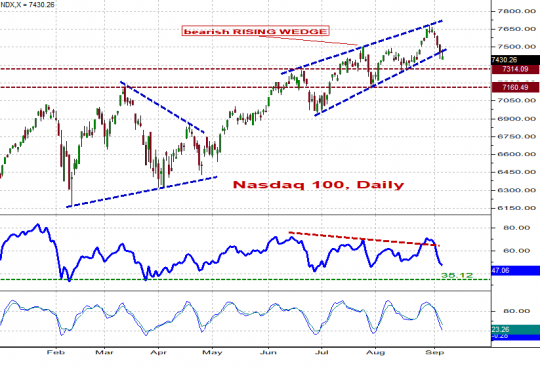
Nasdaq 100, Weekly
UNCHANGED ::: The signs of mid-term fatigue surfacing in all other indices are present in the Nasdaq, too. We will be watching behavior near the 7832 / 8100 targets / resistances for possible hints that a correction is beginning in this time-frame.
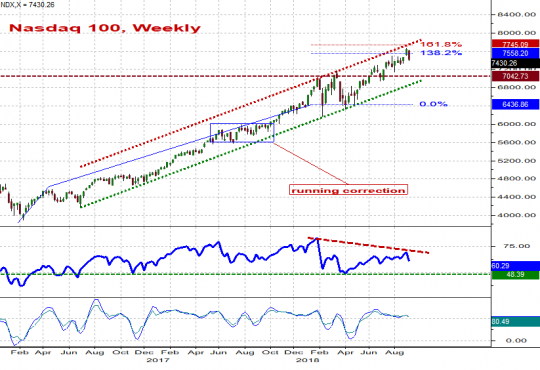 [/vc_column_text][/vc_column][/vc_row][vc_row el_id=”COMPX”][vc_column][vc_column_text]
[/vc_column_text][/vc_column][/vc_row][vc_row el_id=”COMPX”][vc_column][vc_column_text]
Nasdaq Composite, Daily
Likewise, the NAS Composite should stabilize above 7630 – 7726 and begin a push above 8100 or will be exposed to a slide towards 7424 / 7332 and then 6900 / 7000

Nasdaq Composite, Weekly
A developing momentum divergence in this time frame hints at a terminal move. While we have no interest to opposing it prematurely we are keenly watching behavior near the 8137 / 8416 / 8703 targets.
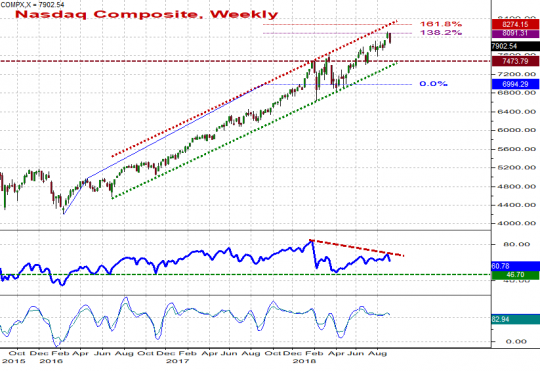 [/vc_column_text][/vc_column][/vc_row][vc_row el_id=”REI”][vc_column][vc_column_text]
[/vc_column_text][/vc_column][/vc_row][vc_row el_id=”REI”][vc_column][vc_column_text]
Weekly Stock Picks
REI
| DIRECTION | BUY ZONE | SELL ZONE | RISK/REWARD | VEHICLE |
| UP | $10-$11 | $13+ | -$.40-+$3.00 | STOCK/OPTIONS |
REI, in a downtrend since mid-May, has recently broken out lower from a falling wedge pattern, in what I think could result in a failed move lower only to break higher. I’ve seen this more and more recently where names are taking out levels, leaving long lower shadows only to bounce back. Friday, REI left a long lower shadow in an Oversold area and we want to play a bounce back up to the value area near $13. While this is an energy name, it is trading almost perfectly inversely to the price of oil as of late so it isn’t dependent on crude trading higher. Watch for a bounce this week.
 [/vc_column_text][/vc_column][/vc_row][vc_row el_id=”TGTX”][vc_column][vc_column_text]
[/vc_column_text][/vc_column][/vc_row][vc_row el_id=”TGTX”][vc_column][vc_column_text]
TGTX
| DIRECTION | BUY ZONE | SELL ZONE | RISK/REWARD | VEHICLE |
| UP | $10.80-12.00 | $14.00+ | -$.70-+$$2.50+ | STOCK |
We’ve had some success with Biotech the past few weeks and here is another name primed for a pop. $TGTX is showing a wedge pattern coming into a support area which is a confluence of the VPOC on the 5 year daily (major support) and this coincides with a 61.8% retracement of the recent major rally starting towards the end of 2017. With implied volatility high it likely makes more sense to trade stock or deep in the money calls as a stock replacement. I like the for the coming weeks.
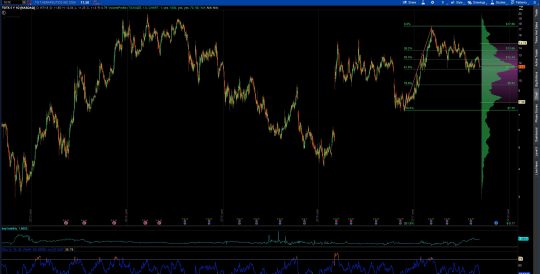 [/vc_column_text][/vc_column][/vc_row][vc_row el_id=”PEP”][vc_column][vc_column_text]
[/vc_column_text][/vc_column][/vc_row][vc_row el_id=”PEP”][vc_column][vc_column_text]
PEP
| DIRECTION | BUY ZONE | SELL ZONE | RISK/REWARD | VEHICLE |
| UP | $110-113 | $120+ | -$2-+$8.00+ | OPTIONS |
The chart of Pepsi has a few things working for it. First, an inverted Head and Shoulders pattern is evident that in bull markets often resolve upward. Next, $PEP is flagging here as it puts in the right shoulder giving us a good entry point. Finally, this is happening near the VPOC which adds another layer of support under where price trades currently. I think in the coming week we get an opportunity to get long $PEP a bit lower and we see price trade back to the $120 area into October. I will be looking at options early in the week. [/vc_column_text][/vc_column][/vc_row][vc_row el_id=”L”][vc_column][vc_column_text]
[/vc_column_text][/vc_column][/vc_row][vc_row el_id=”L”][vc_column][vc_column_text]
L
| DIRECTION | BUY ZONE | SELL ZONE | RISK/REWARD | VEHICLE |
| UP | $49-50 | $53+ | -$1-+$4+ | OPTIONS |
$L is one of the most balanced charts out there right now and we would be remiss not to include it. While it is a slower moving name, when you get a textbook pattern you want to take advantage. Price ran up until selling off early this year, starting a near perfect symmetrical triangle consolidation. We know that these most often act as continuation patterns and price has a better chance of resolving higher. Once we get a breakout, we can use measured move analysis to arrive at a price target of approximately $58. This won’t happen in a hurry but it’s likely to happen.
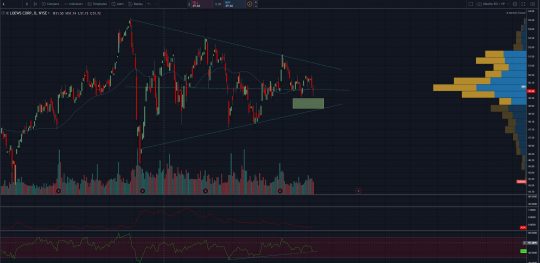 [/vc_column_text][/vc_column][/vc_row][vc_row el_id=”HUYA”][vc_column][vc_column_text]
[/vc_column_text][/vc_column][/vc_row][vc_row el_id=”HUYA”][vc_column][vc_column_text]
HUYA
| DIRECTION | BUY ZONE | SELL ZONE | RISK/REWARD | VEHICLE |
| UP | $24-26 | $48+ | -$2.00-$8+ | OPTIONS |
There might not be a stock with more potential than $HUYA in the market right now. It might take a couple of times to get this right if playing options, so stock is a fair alternative right here and now. A bit of a sloppy falling wedge pattern at the moment but price is coming into the bottom of the value area since its IPO release. If China gets hot, the potential is there for $HUYA to climb out of the falling wedge pattern and back towards the highs near $48 to $50.
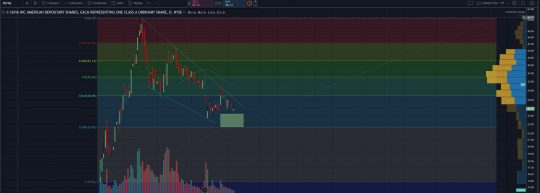 [/vc_column_text][/vc_column][/vc_row][vc_row el_id=”BGNE”][vc_column][vc_column_text]
[/vc_column_text][/vc_column][/vc_row][vc_row el_id=”BGNE”][vc_column][vc_column_text]
BGNE
| DIRECTION | BUY ZONE | SELL ZONE | RISK/REWARD | VEHICLE |
| UP | $160-163 | $220+ | -$3-+$60+ | OPTIONS |
$BGNE reminds me somewhat of $ARWR which made last week’s list. Steady uptrend with a simple pullback and consolidation range formed giving us defined parameters to work with. The stock is sitting right at the lower bound of support which also coincides with the VPOC on the one year daily pattern. A measured move target of $250 over time makes this a candidate to get into this week. I will be shopping this one in the early going Monday morning.
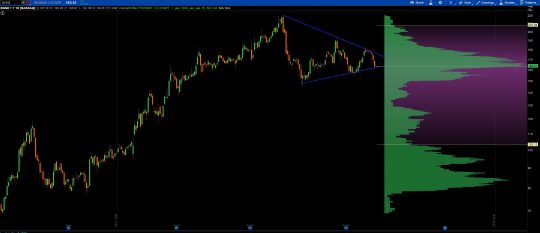 [/vc_column_text][/vc_column][/vc_row][vc_row el_id=”ENLC”][vc_column][vc_column_text]
[/vc_column_text][/vc_column][/vc_row][vc_row el_id=”ENLC”][vc_column][vc_column_text]
ENLC
| DIRECTION | BUY ZONE | SELL ZONE | RISK/REWARD | VEHICLE |
| UP | $16-17 | $20+ | -$1.00-+$3.00+ | OPTIONS/STOCK |
$ENLC is another near textbook triangle setup from which we have defined entry points. In these patterns where you have a symmetrical triangle, it is a good trick to split the range in half which I do by drawing a horizontal line through the center. The goal is to enter the trade below the center line as close to the lower support bound as possible. We play these patterns for a breakout of the range which I think can happen in the coming two weeks in this case. Options are preferred but if spreads are too wide I will be looking at stock this week.
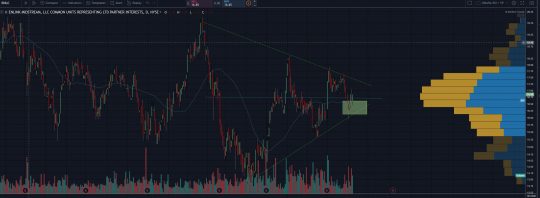 [/vc_column_text][/vc_column][/vc_row][vc_row el_id=”DWDP”][vc_column][vc_column_text]
[/vc_column_text][/vc_column][/vc_row][vc_row el_id=”DWDP”][vc_column][vc_column_text]
DWDP
| DIRECTION | BUY ZONE | SELL ZONE | RISK/REWARD | VEHICLE |
| UP | $68-69 | $77-$80 | -$2-+$$7.00+ | OPTIONS |
$DWDP is coming back into retest the area of the recent breakout of a consolidation range. We know that breakouts often are nice enough to give those who missed the original entry one last chance to jump on before continuing higher. Bullish momentum has been on the uptick since the stock began consolidating and I think that confirms that shortly after this retest DWDP resumes trading higher.
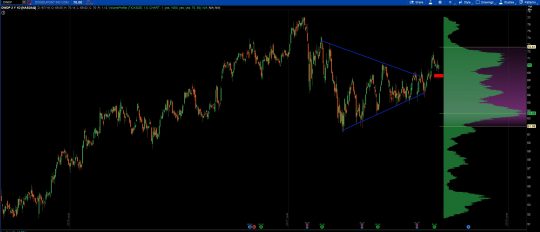 [/vc_column_text][/vc_column][/vc_row][vc_row el_id=”LOXO”][vc_column][vc_column_text]
[/vc_column_text][/vc_column][/vc_row][vc_row el_id=”LOXO”][vc_column][vc_column_text]
LOXO
| DIRECTION | BUY ZONE | SELL ZONE | RISK/REWARD | VEHICLE |
| UP | $154-160 | $178+ | -$6-+$18+ | OPTIONS |
$LOXO is another biotech stock making this list this week. The uptrend the stock has enjoyed throughout 2018 has pulled back to trendline support as well as likely support from a gap up seen in May. The trendline paired with the gap level serve as a defined downside support level from which we can easily decide to exit the trade should it go against us. I think LOXO comes in a few bucks this week and that is where we want to get long. I have an alert said should this fall to $157 I will be in.
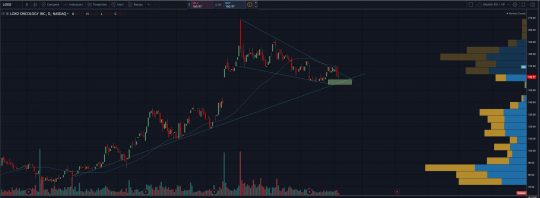 [/vc_column_text][/vc_column][/vc_row][vc_row el_id=”QD”][vc_column][vc_column_text]
[/vc_column_text][/vc_column][/vc_row][vc_row el_id=”QD”][vc_column][vc_column_text]
QD
| DIRECTION | BUY ZONE | SELL ZONE | RISK/REWARD | VEHICLE |
| UP | $5.25-$6 | $12+ | -$.25-+$7.00 | STOCK/OPTIONS |
$QD is playable as it lies in the coming week. Since its IPO $QD has put in a value area with the lower bound at $5.24 and upper bound at $15.59. For those not familiar with auction market theory you may remember from statistics the Gaussian Distribution (Normal Distribution). In its simplest form, we can use our knowledge of a normal distribution to remind us that 70% of all values fall within 1 standard deviation from the mean. This helps us to put upper and lower bounds around price. Price prefers to stay within this region the majority of the time and since it has currently fallen to the low bound and held it so far, I think there is a good chance we see price revert back towards the mean in the coming weeks.
 [/vc_column_text][/vc_column][/vc_row]
[/vc_column_text][/vc_column][/vc_row]

